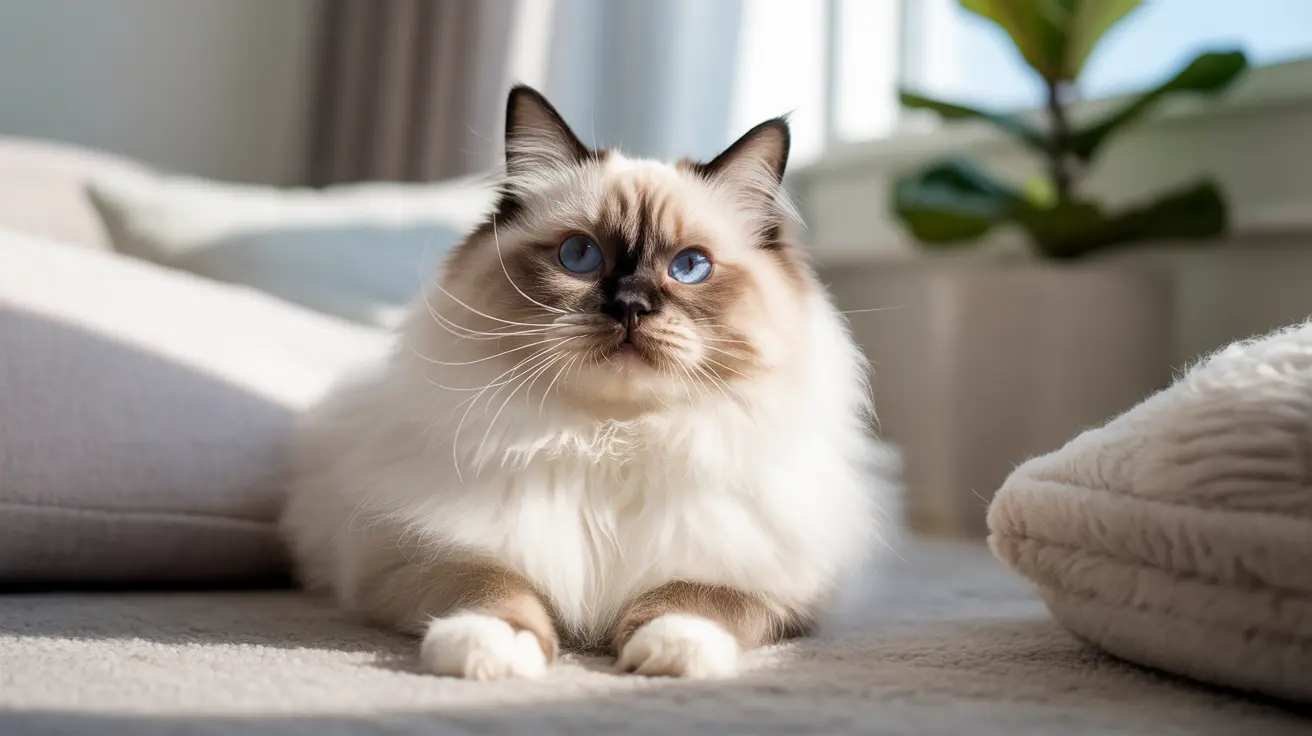7 Essential Cat Body Language Mood Signs Every Owner Should Know
As a cat owner, you've likely found yourself wondering what your feline companion is really thinking. Unlike dogs, who wear their emotions on their sleeves, cats communicate through subtle body language cues that can be easily missed or misinterpreted. Understanding these silent signals is crucial for building a stronger bond with your pet and ensuring their emotional well-being.
Cat body language mood signs are your window into your pet's inner world. From the position of their whiskers to the way they hold their tail, every aspect of your cat's posture tells a story about their current emotional state. Learning to read these signals not only helps prevent conflicts but also allows you to respond appropriately to your cat's needs, whether they're seeking comfort, play, or simply space to decompress.
In this comprehensive guide, we'll explore seven key body language indicators that reveal changes in your cat's mood, helping you become a more intuitive and responsive pet parent. By the end of this article, you'll be equipped with the knowledge to interpret your cat's silent communications and foster a more harmonious relationship with your feline friend.
Understanding Whisker Positioning: Windows to Your Cat's Confidence
Your cat's whiskers are incredibly sensitive mood indicators that often reveal their emotional state before other body language signs become apparent. When cats feel confident and engaged, they push their whiskers forward, displaying curiosity and readiness to interact with their environment. This forward positioning signals that your cat is comfortable and actively processing information from their surroundings.
Conversely, when cats feel fearful, insecure, or threatened, they hold their whiskers close against their face. This protective positioning makes them appear less threatening to potential dangers while also preparing them for potential conflict. Fearful cats essentially try to make themselves appear smaller and less noticeable by pulling their whiskers tight against their cheeks.
Pay attention to subtle whisker movements during your interactions with your cat. If their whiskers suddenly pull back during petting or play, this may indicate they're becoming overwhelmed or uncomfortable and need a break from the interaction.
Decoding the Language of Stares and Eye Contact
Prolonged staring from your cat doesn't necessarily indicate hostility, contrary to what many owners believe. When a cat stares at you for extended periods, they're typically being cautious and watchful, assessing the situation rather than displaying aggression. This behavior often occurs when cats are uncertain about their environment or trying to determine your intentions.
The key to responding appropriately to prolonged staring lies in understanding the peaceful communication tool of slow blinking. When you return your cat's stare with deliberate, slow blinks, you're essentially telling them that you pose no threat and have peaceful intentions. Many cats will respond to this gesture by slow blinking back, which is often called a "cat kiss."
Wide or dilated pupils accompanying a stare can indicate different emotions depending on the context. During play, dilated pupils often signal excitement and engagement. However, when combined with other stress signals like flattened ears or a puffed tail, dilated pupils may indicate fear or anxiety.
Ear Position Changes: Immediate Mood Indicators
Your cat's ears are perhaps the most immediate indicators of mood changes, often shifting position before other body language signs become apparent. Forward-facing ears typically indicate a relaxed, attentive, and confident cat who feels comfortable in their environment. This positioning shows they're actively listening and engaged with their surroundings.
Pinned-back or flattened ears, sometimes referred to as "airplane ears," signal irritation, fear, or that your cat may no longer want to be petted or handled. This ear position serves as an important warning that your cat's tolerance level has been reached and continued interaction may result in defensive behavior.
Ears that turn backward without being completely flattened often indicate your cat is processing concerning sounds or stimuli from their environment. This positioning suggests heightened alertness and potential anxiety about something they've detected that you might not have noticed.
Tail Movements: The Ultimate Mood Barometer
The tail serves as your cat's primary mood barometer, with different positions and movements conveying distinct emotional states. A high, vertical tail typically indicates confidence and friendliness, suggesting your cat feels secure and may be approaching for positive interaction. This upright position often accompanies greeting behaviors and shows your cat is in a social mood.
Tail flicking or quick, sharp movements signal tension, agitation, or internal conflict. Unlike the gentle swaying you might see during hunting play, aggressive tail flicking indicates your cat is becoming overstimulated or frustrated. When you observe this behavior, it's best to give your cat space to avoid potential scratches, hissing, or other defensive reactions.
A low or tucked tail reveals fear or anxiety, while a puffed-up tail indicates your cat feels threatened and is trying to appear larger to potential dangers. Pay particular attention to tail shaking or violent thrashing, as these movements often precede aggressive outbursts and suggest your cat needs immediate space to calm down.
The "Cold Shoulder": Understanding Avoidance Behaviors
When cats ignore calls or deliberately turn away from their owners, this behavior often indicates they're upset, offended, or simply need emotional space. This "cold shoulder" treatment isn't necessarily permanent anger but rather your cat's way of communicating that something has disrupted their comfort or routine.
Cats may display avoidance behaviors after stressful events, changes in their environment, or when they feel their boundaries haven't been respected. Unlike dogs, who might approach their owners for comfort when upset, cats often prefer to process their emotions independently before resuming normal social interactions.
The key to addressing avoidance behavior is patience and respect for your cat's need for space. Attempting to force interaction when your cat is displaying the cold shoulder often prolongs their withdrawal and may damage trust between you and your pet.
Hiding Behaviors: Recognizing the Need for Solitude
Hiding behaviors, such as covering their face with paws, retreating under furniture, or avoiding contact entirely, clearly communicate that your cat wants solitude, rest, or is experiencing stress. These behaviors serve as your cat's way of creating a safe space where they can decompress without external pressures or stimulation.
Cats naturally seek enclosed, quiet spaces when they need to regulate their emotions or recover from overwhelming experiences. Attempting to coax a hiding cat out of their chosen retreat often increases their stress levels and prolongs their recovery time. Instead, ensure they have access to water, food, and their litter box while respecting their need for uninterrupted solitude.
Prolonged hiding that extends beyond a day or two may indicate underlying health issues or significant environmental stressors that require attention. However, short-term hiding is a normal and healthy coping mechanism that should be respected rather than discouraged.
Vocal Changes: When Meowing Becomes a Complaint
Increased and loud meowing often serves as your cat's vocal complaint designed to capture your attention when other communication methods haven't been effective. This escalated vocalization typically indicates your cat has an unmet need or is experiencing frustration about something in their environment.
Unlike their typical communication meows, complaint vocalizations tend to be more persistent, louder, and may have a different tonal quality. These sounds often accompany other body language signs of distress and should prompt you to assess your cat's immediate needs, including food, water, litter box cleanliness, or access to preferred resting areas.
Context is crucial when interpreting increased vocalization. Cats may become more vocal during routine changes, when separated from preferred humans, or when experiencing discomfort. Understanding the circumstances surrounding vocal changes helps you address the root cause rather than just the symptom.
How to Respond Appropriately to Mood Changes
Successfully responding to your cat's mood changes requires combining observation skills with appropriate environmental adjustments and positive reinforcement techniques. When you notice signs of stress or agitation, immediately assess your cat's environment for potential triggers such as loud noises, unfamiliar scents, or disrupted routines.
Creating safe spaces throughout your home gives your cat options for retreat when they need emotional regulation. Vertical perches, cozy hiding spots, and quiet areas away from household activity provide essential resources for cats to manage their own stress levels. Avoid punishment-based responses to negative moods, as these typically increase anxiety rather than resolving the underlying issue.
Positive reinforcement techniques, such as offering treats or gentle praise when your cat displays relaxed body language, help reinforce calm behaviors. However, timing is crucial – rewards should only be offered when your cat is already showing signs of relaxation rather than when they're displaying stress signals.
Building Trust Through Body Language Communication
Cats respond positively to humans who communicate using feline body language cues. Slow blinking, avoiding direct stares, and allowing cats to approach you rather than forcing interaction all demonstrate respect for their communication style. These techniques help build trust and reduce stress in your relationship.
New cat owners particularly benefit from learning to read subtle signals before they escalate into more obvious warnings. Early intervention when you notice initial signs of discomfort or overstimulation prevents conflicts and helps establish positive interaction patterns. Understanding that cats need processing time between stimulating experiences helps you pace interactions appropriately.
Mirroring calm body language back to your cat, such as slow movements and relaxed posture, can help de-escalate tense situations. Cats often mirror the energy levels of their environment, so maintaining calm, patient demeanor during mood changes encourages emotional regulation.
Frequently Asked Questions
Q: How can I tell if my cat's tail flicking means they're playful or agitated?
Context is key to interpreting tail flicking. During play, tail flicking often occurs alongside dilated pupils, forward ears, and stalking behaviors. Agitated tail flicking typically appears with other stress signals like flattened ears, tense posture, or attempts to create distance from stimuli.
Q: Why does my cat stare at me without blinking?
Prolonged staring usually indicates your cat is being cautious and assessing the situation rather than showing aggression. Respond with slow, deliberate blinks to communicate peaceful intentions. Your cat may blink back, which is a positive sign of trust.
Q: Should I pet my cat when they show their belly?
Belly exposure can indicate trust, but it's not always an invitation for petting. Many cats display their bellies as a defensive posture. Look for other relaxed body language signs like slow blinking and forward ears before attempting belly contact.
Q: How long should I give my cat space when they're hiding?
Short-term hiding lasting a few hours to a day is normal stress management. Ensure your cat has access to necessities while respecting their solitude. If hiding extends beyond two days or is accompanied by other concerning behaviors, consult your veterinarian.
Q: Can I train my cat to respond differently to stressful situations?
While you can't change your cat's natural responses, you can modify their environment to reduce stress triggers and use positive reinforcement to encourage calm behaviors. Providing adequate resources, maintaining routines, and respecting boundaries helps cats develop better coping strategies.
Q: What's the difference between fear-based and pain-related body language changes?
Both fear and pain can cause similar body language like crouching, hiding, or aggression. Pain-related changes often persist across different situations, while fear responses typically relate to specific triggers. Sudden behavioral changes warrant veterinary examination to rule out medical issues.
Q: How do I know if my cat's increased vocalization is normal or concerning?
Sudden increases in vocalization, especially when accompanied by other behavioral changes like appetite loss or litter box issues, may indicate health problems. Gradual changes related to routine disruptions or attention-seeking are typically behavioral. When in doubt, consult your veterinarian.
Conclusion
Understanding cat body language mood signs transforms your relationship with your feline companion from guesswork to informed communication. By recognizing the seven key indicators we've discussed – whisker positioning, eye contact patterns, ear movements, tail signals, avoidance behaviors, hiding tendencies, and vocal changes – you become better equipped to respond appropriately to your cat's emotional needs.
Remember that each cat is an individual with unique personality traits and preferences. While these body language fundamentals apply broadly, spending time observing your specific cat's patterns and triggers allows you to develop even more nuanced understanding of their communication style. This investment in learning your cat's language pays dividends in reduced stress for both of you and a stronger, more trusting bond that enhances your shared life together.





